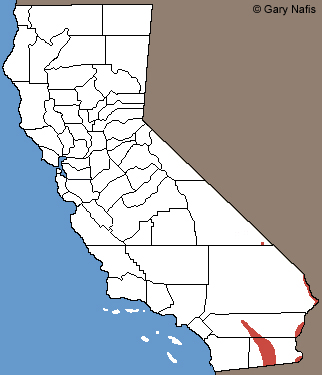|
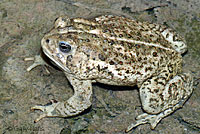 |
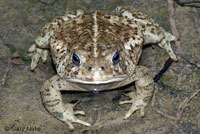 |
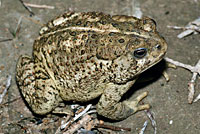 |
| Adult male, Riverside County |
Adult male, Riverside County |
Adult male, Riverside County |
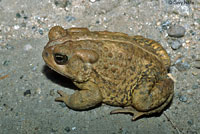 |
 |
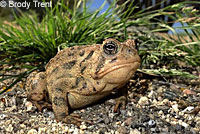 |
| Adult, Riverside County |
Adult male, Riverside County |
Adult, Riverside County
© Brody Trent
|
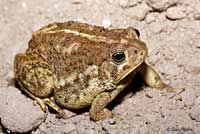 |
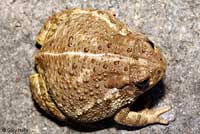 |
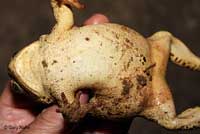 |
| Adult female, Imperial County near Colorado River north of Yuma |
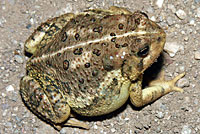 |
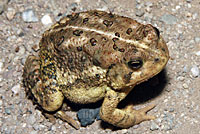 |
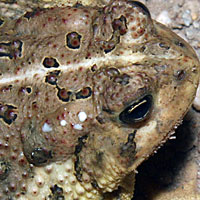 |
| Adult, Imperial County |
Noxious white secretions from
paratoid gland. |
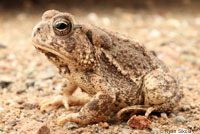 |
 |
 |
Adult, eastern Riverside County
© Ryan Sikola |
Adult, eastern Riverside County
© Ryan Sikola |
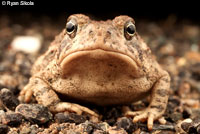 |
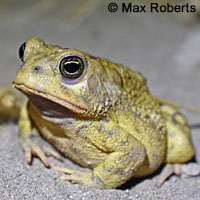 |
|
Adult, eastern Riverside County
© Ryan Sikola |
This abnormally-yellow adult toad was photographed in Riverside County
© Max Roberts |
|
| |
|
|
| Rocky Mountain Toads From Outside California |
 |
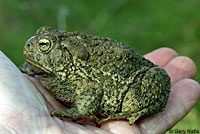 |
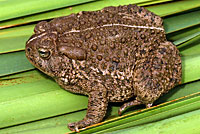 |
Adult, Yuma County, Arizona
|
Adult male,
Franklin County, Washington |
Adult, Franklin County, Washington |
 |
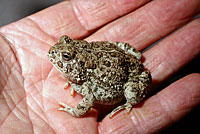 |
 |
Sub-adult,
Franklin County, Washington |
Juvenile, Franklin County, Washington |
Underside, Franklin County, Washington |
| |
|
|
| Males Calling during Breeding Season |
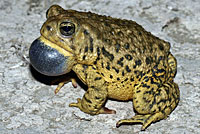 |
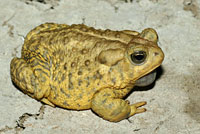 |
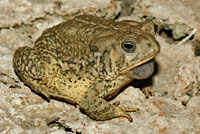 |
Adult male calling at night from the shore of breeding pond,
Riverside County. |
Adult male calling at night from the shore of breeding pond,
Riverside County. |
Adult male calling at night from the shore of breeding pond,
Riverside County. |
| |
|
|
| Eggs and Tadpoles |
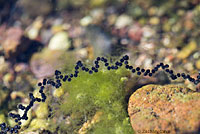 |
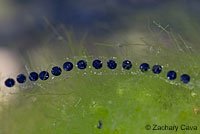 |
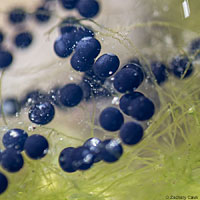 |
| Egg strings, Clark County, Nevada © Zachary Cava |
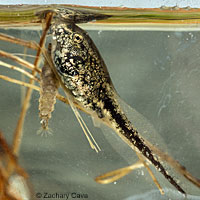 |
 |
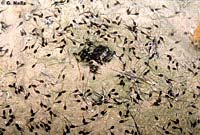 |
| Tadpole, Clark County, Nevada © Zachary Cava |
Tadpoles, Riverside County
|
| |
|
|
| Identification Details and Comparison With Sympatric A. cognatus |
 |
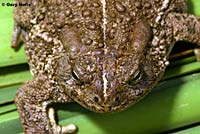 |
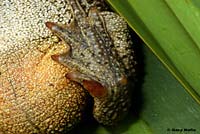 |
Elongated paratoid glands
behind the eyes |
Cranial crests between eyes |
Digging Spade on hind foot |
| |
 |
|
| |
Comparison of Anaxyrus woodhousii on left and Anaxyrus cognatus on right.
The cranial crests of A. cognatus point inward at the front, often coming together.
The parotoid glands of A. woodhousii are more elongated than on A. cognatus.
|
|
| |
|
|
| Rocky Mountain Toad Habitat in California |
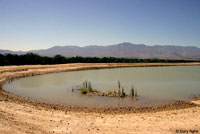 |
 |
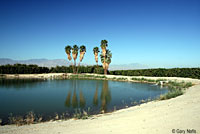 |
| Breeding habitat - irrigation pond in orchard, Riverside County |
Habitat, agricultural irrigation canal
Imperial County |
Habitat, agricultural irrigation pond, Riverside County |
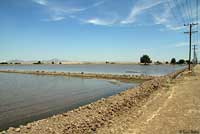 |
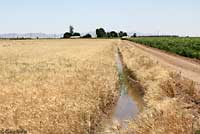 |
|
| Breeding habitat, Imperial County |
Habitat, Imperial County farmland |
|
More pictures of this toad from Washington are on our Northwest Herps page.
|
| Short Videos |
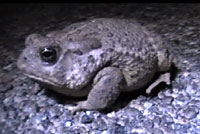 |
 |
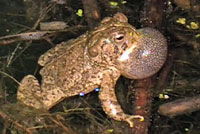 |
360 degrees of toad sitting on a road at night. The toad would not move, so the camera had to.
|
Rocky Mountain Toads calling at night on a pond in Franklin County, Washington. |
A short example of a male giving one advertisement call at night on a pond in Franklin County, Washington. |
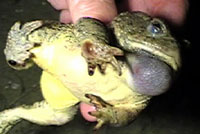 |

|
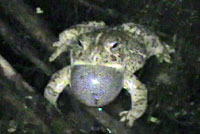 |
| Two calling males pulled from a breeding pond in Riverside County are shown giving weak release calls before being returned to the water. |
A Rocky Mountain Toad gives a release call when he is picked up. |
Rocky Mountain Toads calling at night on a pond in Franklin County, Washington. |
| |
|
|
|
Description |
| |
| Size |
Adults are 1.75 - 5 inches from snout to vent ( 4.4 - 12.7 cm). (Stebbins, 2003)
|
| Appearance |
A large toad with dry, warty skin.
Prominent cranial crests, sometimes with a boss between them, which contact the elongated, divergent parotoid glands. |
| Color and Pattern |
Gray, brownish, olive, greenish, yellow above, with dark blotches.
A
whitish stripe is present on the middle of the back to the snout.
A
network of black and yellow marks the rear of the thighs.
Color underneath is pale cream or beige, with or without dark spots. |
| Male/Female Differences |
| Male's throat is dark in color, female's is not. |
| Young |
| Young may have no dorsal stripe. |
| Larvae (Tadpoles) |
Color is generally black, and the venter of the tail is pale.
|
| Life History and Behavior |
| Activity |
Nocturnal, remaining underground in the daytime, but occasionally seen moving about in daylight or resting at the edge of breeding pools in the breeding season.
Woodhouse's Toads are presumed to hibernate from about October to February over most of their range. They may cease activity during the winter in California, but this is not certain. |
| Movement |
| Typical of most toads, A. woodhousii moves relatively slowly, often using a walking or crawling motion along with short hops. |
| Defense |
| As most toads do for defense, this toad relies on parotoid glands and warts which can secrete a poison that deters some predators. |
| Voice (Listen) |
Woodhouse's Toad makes a loud call that sounds like a muted sheep or calf bleating, or a snore, lasting 1 - 4 seconds.
Calls are made from dusk to dawn from quiet waters of ponds, streams, irrigation ditches, and marshes.
Males call from various locations near breeding ponds - from shallow water, on dry shore edge, and on land near water. |
| Diet and Feeding |
Diet probably consists of a wide variety of invertebrates.
Prey is located by vision, then the toad lunges with a large sticky tongue to catch the prey and bring it into the mouth to eat. |
| Reproduction |
Reproduction is aquatic.
Fertilization is external, with the male grasping the back of the female and releasing sperm as the female lays her eggs.
The reproductive cycle of Woodhouse's Toads is similar to that of most North American Frogs and Toads. Mature adults come into breeding condition and migrate to ponds or ditches where the males call to advertise their fitness to competing males and to females. Males and females pair up in amplexus in the water where the female lays her eggs as the male fertilizes them externally. The adults leave the water and the eggs hatch into tadpoles which feed in the water and eventually grow four legs, lose their tails and emerge onto land where they disperse into the surrounding territory.
Throughout its range, mating and egg-laying occurs from February to September, usually during or after rains. In California, breeding occurs at least from March through August. (Personal observation.)
Males are presumed to reach reproductive maturity in one year, females in two years. |
| Eggs |
Eggs are laid in long strings and attached to vegetation in shallow water.
Midwestern toads studied laid clutches of a maximum of about 28,000 eggs. (Lannoo, 2005)
|
| Tadpoles and Young |
Tadpoles often form large aggregations.
Tadpoles metamorphose in 5 - 8 weeks when they are under 1 inch in length (2.5 cm). (Stebbins, 2003)
|
| Hybrids |
Hybridizes with many other species. Species in our area that it is known to hybridize elsewhere are A. punctatus,
A. alvarius, A. microscaphus, and A. cognatus.
|
| Habitat |
Throughout its range, this toad inhabits a wide variety of habitats - irrigation ditches, temporary pools, moist meadows, grassland, ponds, lakes, reservoirs, sagebrush flats, woods, desert streams, farms, river floodplains, irrigation canals, irrigated fields and golf courses. In California, mostly found in irrigated agricultural areas, but may be spreading into irrigated areas in the Coachella Valley. Prefers sandy areas.
|
| Geographical Range |
In California, the subspecies Anaxyrus woodhousii woodhousii is found in the southeast - along the Colorado River, in the Imperial Valley, and north to the Palm Springs area where it may be continuing to expand its range to the west.
A population was found in 2012 in Inyo County on the Amargosa River just south of Tecopa.
(Pers. comm.)
[Herpetological Review 44(2), 2013]
Another Inyo County population was found in 2013 in Tecopa in the drainage to the east of the Amargosa River location at China Ranch. (Pers. comm.)
Outside of California this subspecies occurs in isolated populations in southern Washington, extreme east Oregon and part of western Idaho, southern Nevada, eastern Montana, North Dakota, south to Texas.
The species Anaxyrus woodhousii occurs throughout much of the central United States west of the Mississippi River, eastern Louisiana, Arizona, New Mexico and norther Mexico, including extreme northern Baja California, and in isolated populations in southern Washington, Oregon, and Idaho.
Some authors* include the toads inhabiting the southern part of the state with the subspecies A. w. australis (not the subspecies A. w. woodhousii, which I show them to be here.) They also include the toads inhabiting the area near the Nevada border with the subspecies A. w. woodhousii. Old field guides and museum records that include subspecies information, list the southern populations as A. w. woodhousii, but some recent research analyzing advertisement call variation ** has indicated that the southern California toads are more closely related to those in south-central Arizona, which are A. w. australis. (It does seem likely that this subspecies could have entered California through the Gila River drainage.)
* Bartlett, R. D. & Patricia P. Bartlett. Guide and Reference to the Amphibians of Western North America (North of Mexico) and Hawaii. University Press of Florida, 2009.
** Brian K. Sullivan, Keith B. Malmos, Mac F. Given. Systematics of the Bufo woodhousii Complex (Anura: Bufonidae): Advertisement Call Variation. Copeia, Vol. 1996, No. 2 (May 16, 1996), pp. 274-280
|
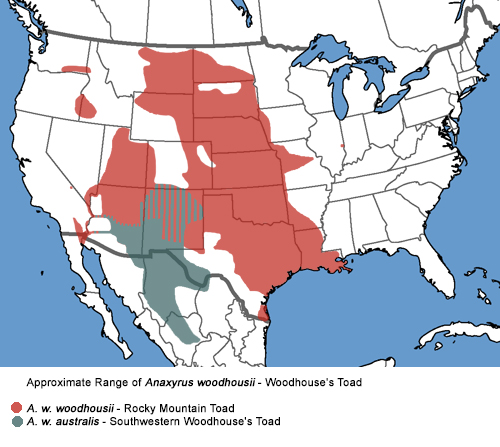 |
| Elevational Range |
From near sea level to around 8,500 ft. (2590 m.) (Stebbins, 2003)
|
| Notes on Taxonomy |
Anaxyrus woodhousii taxonomy is undergoing some changes. Some authorities do not recognize any subspecies of Anaxyrus woodhousii, referring to this toad as Woodhouse's Toad. Others recognize several subspecies.
----------------------------------------------------------------------------------------------------------------------------------------------------------------------
Formerly included in the genus Bufo. In 2006, Frost et al replaced the long-standing genus Bufo in North America with
Anaxyrus, restricting Bufo to the eastern hemisphere. Bufo is still used in most existing references.
----------------------------------------------------------------------------------------------------------------------------------------------------------------------
Nicholson, K. E. (ed.). 2025 SSAR Scientific and Standard English Names List mention that:
"The incorrect spelling of the species name as woodhousei has been used widely. "
----------------------------------------------------------------------------------------------------------------------------------------------------------------------
Alternate and Previous Names (Synonyms)
Bufo woodhousii - Woodhouse's Toad (Stebbins 2003, Stebbins & McGinnis 2012)
Bufo woodhousii woodhousii - Western Woodhouse Toad (Stebbins 1985)
Bufo woodhousii woodhousii - Rocky Mountain Toad (Stebbins 1966)
Bufo woodhousii - Woodhouse's Toad (Stebbins 1954)
Bufo woodhousii woodhousii - Rocky Mountain Toad (Woodhouse's Toad, American Toad) (Wright and Wright 1949)
Bufo woodhousii - Rocky Mountain Toad (Storer 1925)
Bufo woodhousii woodhousii - Rocky Mountain Toad - Woodhouse's Toad, American Toad (Grinnell and Camp 1917)
Bufo lentiginosus woodhousii (Cope 1889)
Bufo dorsalis (Hallowell 1852)
|
| Conservation Issues (Conservation Status) |
In some areas this toad is benefiting from water impoundments for agriculture where other native species are in decline.
The Amargosa River population is of concern because this puts the toads about 90 miles south in the same river system as the very localized Amargosa Toad - A. nelsoni which is only found in a 10 mile stretch of the Amargosa River in Oasis Valley, Nevada. |
|
| Taxonomy |
| Family |
Bufonidae |
True Toads |
Gray, 1825 |
| Genus |
Anaxyrus |
North American Toads |
Tschudi, 1845 |
| Species |
woodhousii |
Woodhouse's Toad |
(Girard, 1854) |
| Subspecies |
woodhousii |
Rocky Mountain Toad
|
(Girard, 1854) |
|
Original Description |
Bufo woodhousii - Girard, 1854 - Proc. Acad. Nat. Sci. Philadelphia, Vol. 7, p. 86
from Original Description Citations for the Reptiles and Amphibians of North America © Ellin Beltz
Eponyms
First described by the French herpetologist Charles Frederic Girard in 1854, who honored Samuel Washington Woodhouse (1821-1904), an American surgeon, explorer, and naturalist, in the specific name "Anaxyrus woodhousii" and the common name for the species "Woodhouse's Toad."
See: Biographies of Persons Honored in the Herpetological Nomenclature © Ellin Beltz
|
|
Meaning of the Scientific Name |
Bufo - toad
Anaxyrus - Greek = A king or chief
woodhousii - honors Woodhouse, Samuel W.
Taken in part from Scientific and Common Names of the Reptiles and Amphibians of North America - Explained © Ellin Beltz
|
|
Related or Similar California Frogs |
Anaxyrus cognatus
Anaxyrus boreas halophilus
Anaxyrus punctatus
|
|
More Information and References |
California Department of Fish and Wildlife
AmphibiaWeb
Hansen, Robert W. and Shedd, Jackson D. California Amphibians and Reptiles. (Princeton Field Guides.) Princeton University Press, 2025.
Stebbins, Robert C., and McGinnis, Samuel M. Field Guide to Amphibians and Reptiles of California: Revised Edition (California Natural History Guides) University of California Press, 2012.
Stebbins, Robert C. California Amphibians and Reptiles. The University of California Press, 1972.
Flaxington, William C. Amphibians and Reptiles of California: Field Observations, Distribution, and Natural History. Fieldnotes Press, Anaheim, California, 2021.
Nicholson, K. E. (ed.). 2025. Scientific and Standard English Names of Amphibians and Reptiles of North America North of Mexico, with Comments Regarding Confidence in Our Understanding. Ninth Edition. Society for the Study of Amphibians and Reptiles. [SSAR] 87pp.
Samuel M. McGinnis and Robert C. Stebbins. Peterson Field Guide to Western Reptiles & Amphibians. 4th Edition. Houghton Mifflin Harcourt Publishing Company, 2018.
Stebbins, Robert C. A Field Guide to Western Reptiles and Amphibians. 3rd Edition. Houghton Mifflin Company, 2003.
Behler, John L., and F. Wayne King. The Audubon Society Field Guide to North American Reptiles and Amphibians. Alfred A. Knopf, 1992.
Robert Powell, Roger Conant, and Joseph T. Collins. Peterson Field Guide to Reptiles and Amphibians of Eastern and Central North America. Fourth Edition. Houghton Mifflin Harcourt, 2016.
Powell, Robert., Joseph T. Collins, and Errol D. Hooper Jr. A Key to Amphibians and Reptiles of the Continental United States and Canada. The University Press of Kansas, 1998.Corkran, Charlotte & Chris Thoms. Amphibians of Oregon, Washington, and British Columbia. Lone Pine Publishing, 1996.
Jones, Lawrence L. C. , William P. Leonard, Deanna H. Olson, editors. Amphibians of the Pacific Northwest. Seattle Audubon Society, 2005.
Leonard et. al. Amphibians of Washington and Oregon. Seattle Audubon Society, 1993.
Nussbaum, R. A., E. D. Brodie Jr., and R. M. Storm. Amphibians and Reptiles of the Pacific Northwest. Moscow, Idaho: University Press of Idaho, 1983.
American Museum of Natural History - Amphibian Species of the World 6.2
Bartlett, R. D. & Patricia P. Bartlett. Guide and Reference to the Amphibians of Western North America (North of Mexico) and Hawaii. University Press of Florida, 2009.
Elliott, Lang, Carl Gerhardt, and Carlos Davidson. Frogs and Toads of North America, a Comprehensive Guide to their Identification, Behavior, and Calls. Houghton Mifflin Harcourt, 2009.
Lannoo, Michael (Editor). Amphibian Declines: The Conservation Status of United States Species. University of California Press, June 2005.
Storer, Tracy I. A Synopsis of the Amphibia of California. University of California Press Berkeley, California 1925.
Wright, Albert Hazen and Anna Wright. Handbook of Frogs and Toads of the United States and Canada. Cornell University Press, 1949.
Davidson, Carlos. Booklet to the CD Frog and Toad Calls of the Pacific Coast - Vanishing Voices. Cornell Laboratory of Ornithology, 1995.
Joseph Grinnell and Charles Lewis Camp. A Distributional List of the Amphibians and Reptiles of California. University of California Publications in Zoology Vol. 17, No. 10, pp. 127-208. July 11, 1917.
|
|
|
The following conservation status listings for this animal are taken from the July 2025 State of California Special Animals List and the July 2025 Federally Listed Endangered and Threatened Animals of California list (unless indicated otherwise below.) Both lists are produced by multiple agencies every year, and sometimes more than once per year, so the conservation status listing information found below might not be from the most recent lists, but they don't change a great deal from year to year.. To make sure you are seeing the most recent listings, go to this California Department of Fish and Wildlife web page where you can search for and download both lists:
https://www.wildlife.ca.gov/Data/CNDDB/Plants-and-Animals.
A detailed explanation of the meaning of the status listing symbols can be found at the beginning of the two lists. For quick reference, I have included them on my Special Status Information page.
If no status is listed here, the animal is not included on either list. This most likely indicates that there are no serious conservation concerns for the animal. To find out more about an animal's status you can also go to the NatureServe and IUCN websites to check their rankings.
Check the current California Department of Fish and Wildlife sport fishing regulations to find out if this animal can be legally pursued and handled or collected with possession of a current fishing license. You can also look at the summary of the sport fishing regulations as they apply only to reptiles and amphibians that has been made for this website.
This toad is not included on the Special Animals List, meaning there are no significant conservation concerns for it in California according to the Dept. of Fish and Game.
|
| Organization |
Status Listing |
Notes |
| NatureServe Global Ranking |
|
|
| NatureServe State Ranking |
|
|
| U.S. Endangered Species Act (ESA) |
None |
|
| California Endangered Species Act (CESA) |
None |
|
| California Department of Fish and Wildlife |
None |
|
| Bureau of Land Management |
None |
|
| USDA Forest Service |
None |
|
| IUCN |
|
|
|
|
|
